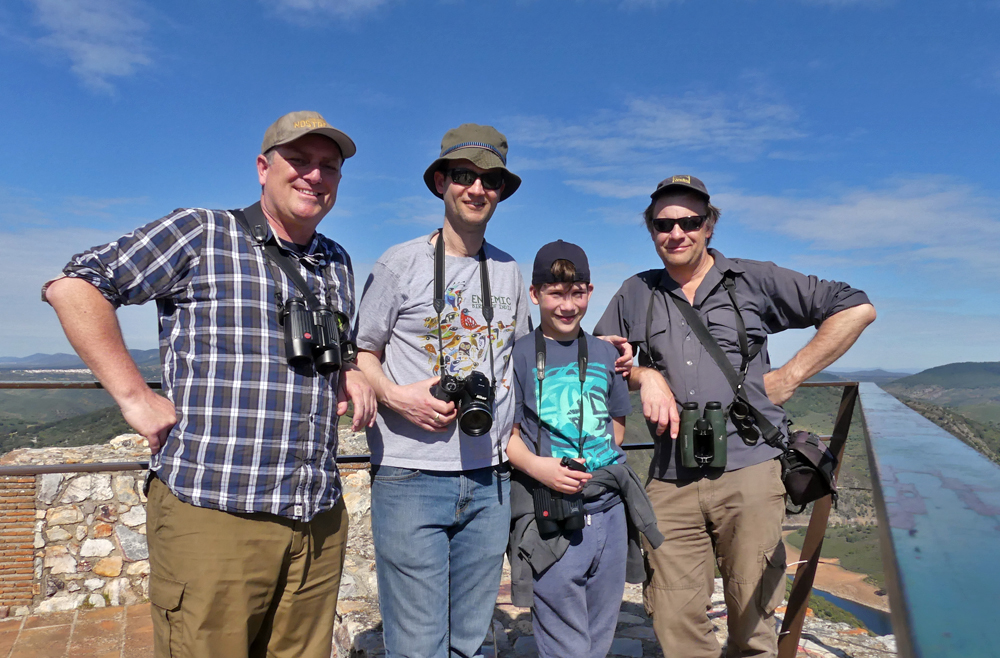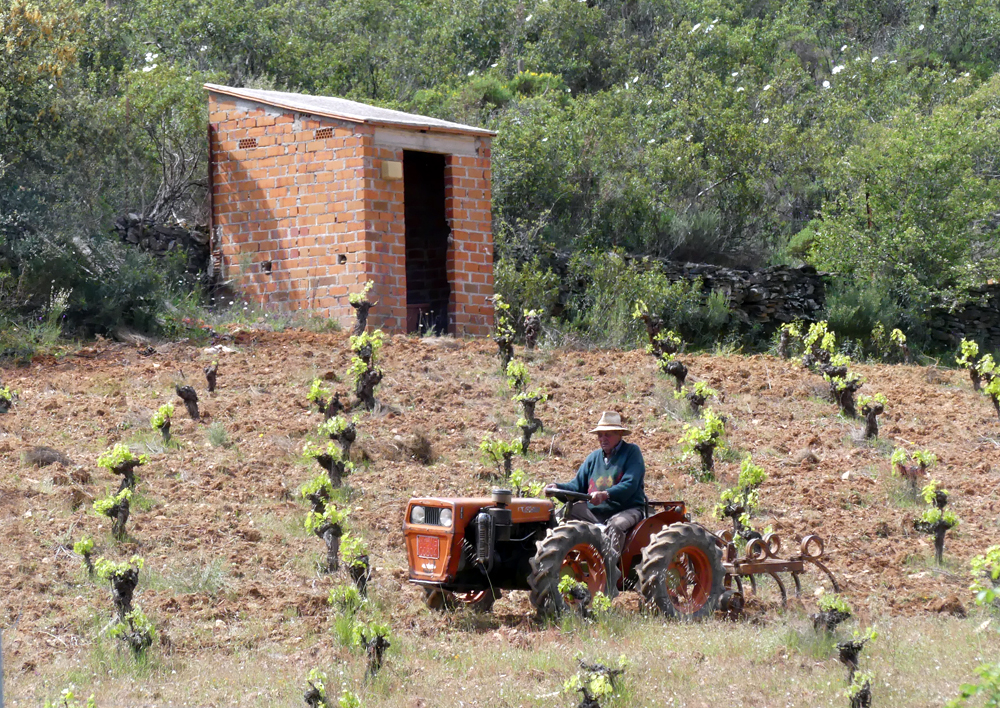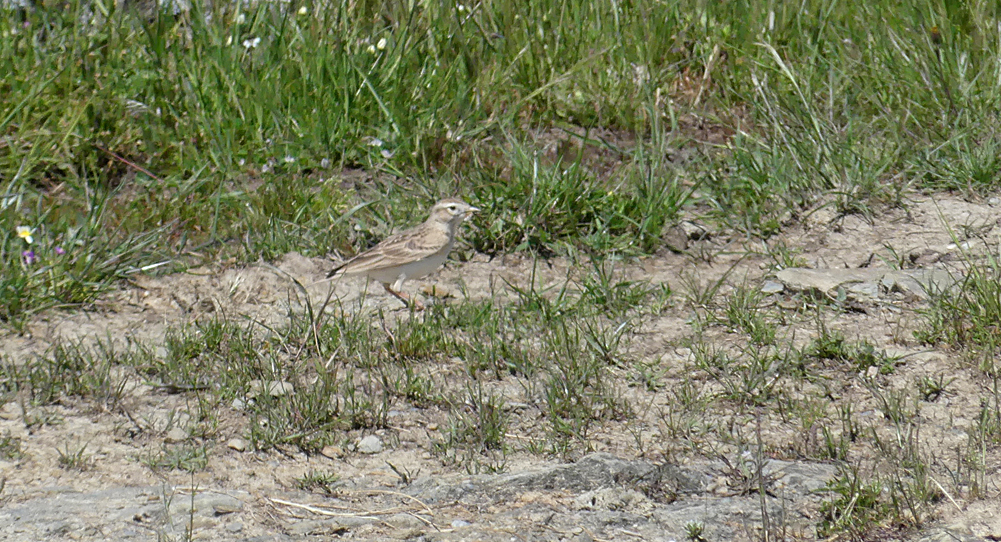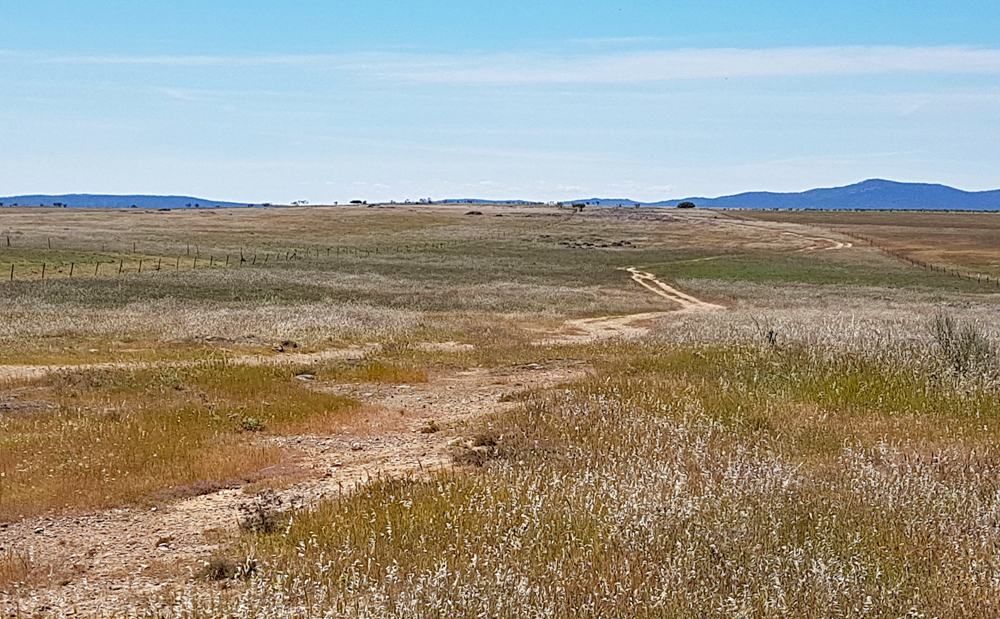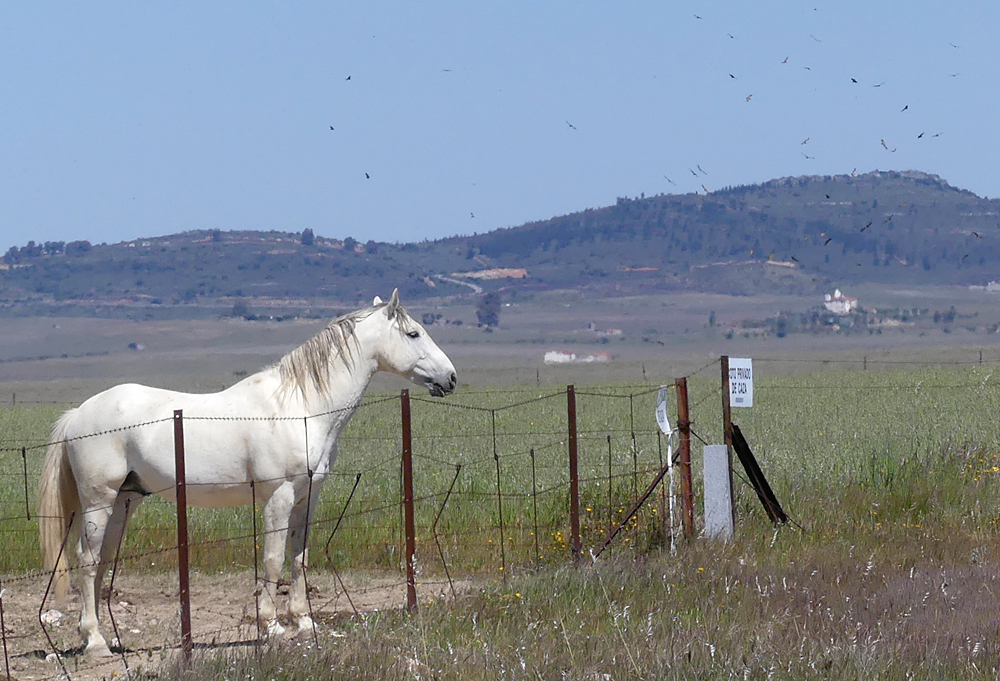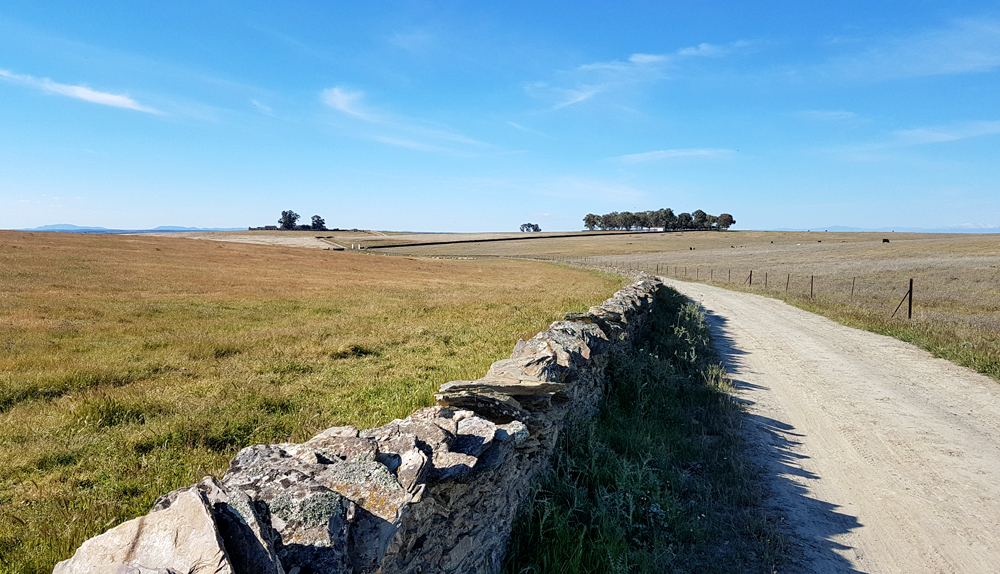Saturday 13th April 2019 (a)
/BUBO in ESPAÑA - part 4
The plan for the second full day in Spain was to visit the famous Montfrague National Park, a place I had been desperate to visit for a long time. Since I had seen all my target ticks, I was looking forward to some pretty laid back birding too. We decided not to breakfast in the hotel today but grab something out and so we were ready a bit earlier than the previous day. I wandered out to the car first and sat outside the smashing little church in the centre of Plasenzuela, with the orange trees surrounding it and a Hoopoe singing from the weather cock at the top. Andy came out and, as we were packing up the car for the day, we looked up to see two Great Bustards lazily flapping over the village square, barely above roof height, flashing their white wing patches on every downbeat. Probably flying between their roost and feeding sites, Ian and Daniel chose an excellent time to appear from the hotel and managed to see them too.
Plasenzuela Church, 13 Apr 19
We headed north out of the town and, just by the roadside, we drove past a fine Iberian Grey Shrike. The taxonomic status of this species is a little odd, with it currently classed as a separate species from Great Grey Shrike, despite subspecies of Great Grey existing north, east and south of its range. It does look very different from the pale ones we get in the UK, being dark, dull grey above, and pinkish-grey below, with a short, narrow supercilium - very distinctive. I had seen one before but I think this was from a moving car back in 1991, so it was more or less a new bird for me.
Iberian Grey Shrike - near Plasenzuela, 13 Apr 19
We headed towards Trujillo then turned off north along the long, straight road towards Montfrague. When the road dropped down into the shallow valley of the Rio Almonte we decided it was a good spot to have a break and we parked up by the bridge. The area had plenty of life with Nightingale, Cetti’s and Fan-tailed Warblers singing in the wetter areas and an army of frogs were creating rather a cacophony of croaks. A Common Sandpiper flushed down the river where a Spanish Terrapin loafed, and a few groups of Bee-eaters went over. As I was trying to take pictures of the resident Crag Martins, Andy picked out a brown bird fly into a riverside tree. As we were trying to refind it, it flew out and revealed itself to be another Rock Sparrow. This bird gave much better flight views as it went past us, but didn’t stop this time and disappeared from view. It was a lovely little spot but breakfast was calling us.
Crag Martin - Rio Almonte, 13 Apr 19
Crag Martin - Rio Almonte, 13 Apr 19
Crag Martin - Rio Almonte, 13 Apr 19
The next village was Torrejon El Rubio and the first building was a hotel with a picture of a Spanish Imperial Eagle painted on the sign. Clearly we had to stop there for some ‘desayuno’ and drinks. I can’t remember what I had (but it was probably eggs) but we were soon on our way towards the park. The Montfrague area is a huge expanse of unbroken, open woodland and it was much, much greener than I expected. We parked up in the car park below the Castillo for a walk up the path to the lookout. As it was now the weekend, this was quite a touristy spot and we had to share the path with many visitors.
View from the car park, Montfrague, 13 Apr 19
It was much warmer and sunnier than the previous day and we headed on up the steep path/road towards the top of the ridge where the Castillo was perched on top of the ridge. We wondered whether the Chiffchaff calling from the trees might be Iberian put I don’t think they breed around here. There were plenty of birds flicking about in the trees either side but they were mostly common species. A singing Nightingale by the path was typically and frustratingly elusive. As I was taking my time trying to get a view of this bird I had dropped back from the others and couldn’t see them ahead of me on the path. As I tried to quicken my pace, a warbler appeared in the bushes in front of me on the left hind side and flew across into a small oak tree on the right hand side. It looked a bit Blackcap-ish but was a different colour and so I tried to get a proper look. I waited by the tree, peering between the boughs, and suddenly, right in front of me was a bobby-dazzler of an Orphean Warbler, with white eye gleaming through the shade of the leaves. Much better views than the previous day. Unfortunately the others were too far ahead to shout to and the bird slinked away. When I caught them up at the sharp bend they were watching a nice flock of Griffon Vultures circling really close just above their heads.
Griffon Vulture - Castillo de Montfrague, 13 Apr 19
Griffon Vulture - Castillo de Montfrague, 13 Apr 19
We rounded the bend and the Castillo was now right above us. A Black Redstart was singing from the bushes below the rock face. There was more singing in the trees below the road and one of the songs appeared to be another Orphean Warbler. It was in a larger trees and we kept getting brief views as it flicked around in the back branches. It was definitely not fancying to be photographed but it sang almost constantly. I managed a few recordings of the song (see below). We climbed up to the castle which is perched on the highest point of Montfrague. It is not a particularly impressive castle and there does not seem to be much of the 1000 year old original left, but we were able to climb up some narrow stone stairs to the roof, where there was a magnificent 360 degree view of the whole area. From here we could appreciate just how massive the Montfrague Park is and the habitat is immense. If we could find 2 Orpheans in just a short walk, there must be huge numbers breeding in this vast expanse. Up on the top we saw a couple of quick-moving lizards and a fly-past Blue Rock Thrush.
Steps up to Castillo de Montfrague, 13 Apr 19
Looking south from from Castillo de Montfrague, 13 Apr 19
Looking north from Castillo de Montfrague, 13 Apr 19
BUBO atop Castillo de Montfrague, 13 Apr 19
After we had started making our way down we were stopped by a couple of European photographers on the pathside below the Castillo, who told us that they were taking pictures of a Rock Bunting which was coming down to feed on the grass. This made sense because we had seen/heard a very brief unknown bunting from the top, near to where this was. Almost immediately, a fine male Rock Bunting flew down and started picking grass and seeds from the small patch of vegetation between us and the rock. It was very close but moved so fast it was difficult to photograph. I had not seen this species for many years and it was one bird I was looking forward to seeing - and this one certainly didn’t disappoint.
Rock Bunting - Castillo de Montfrague, 13 Apr 19
As we continued down the path towards the car we saw a few species we hadn’t seen on the way up. A Black Stork appeared in the sky amongst the vultures and gave great views as it soared through the blue sky. They breed on the rock faces nearby. Also further down we heard a Sylvia-like song and located a nice male Subalpine Warbler from the top of a tree. We soon found that, compared to many others of the same genus, the Subalps were more than happy to sing out in the open to be admired. I also recorded my first alive Sardinian Warbler of the trip and a Woodlark was singing from somewhere through the trees. In the skies above, as well as the aforementioned species, we had Ravens, Bee-eaters, Black Kites, a Booted and a Short-toed Eagle all enjoying the sunny weather. Right down by the car park, amongst many other insects, I saw a Painted Lady and also a third Orphean Warbler could be heard belting out its thrush-like song from the nearby bushes.
Black Stork - Castillo de Montfrague, 13 Apr 19
Subalpine Warbler - Castillo de Montfrague, 13 Apr 19
Back at the car we headed on further into the park. We planned to have a stop at Salto del Gitano, a famous spot to view a vulture colony, but it was so overloaded with tourists we couldn’t see anywhere to park. So instead we carried on north, over the river and into the tiny settlement of Villareal de San Carlos, where a small café looked too inviting to miss. I didn’t fancy eating, but after downing a glorious ice cold coke and watching the Swallows that were breeding right above our heads, I went for a little wander round the immediate vicinity. My eyes were immediately drawn to a butterfly perched on a fence which looked a bit odd. I identified it as a Nettle-tree Butterfly and it spent its time around one or two recently planted trees which were, I presumed, Nettle Trees. This species is an unusual beastie with its strange wing shape and even stranger beak, and I watched it lay eggs on the just-opening leaves. After we decided that we were refreshed enough, the time had ticked onto midday and we headed off to see what further delights we could find in Montfrague during the afternoon.
Lunchtime café, Montfrague, 13 Apr 19
Nettle-tree Butterfly - Montfrague, 13 Apr 19
Nettle-tree Butterfly - Montfrague, 13 Apr 19
Nettle-tree Butterfly laying eggs - Montfrague, 13 Apr 19
Montfrague farmer, 13 Apr 19












